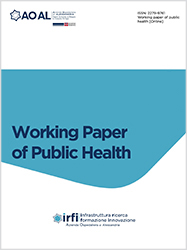Implementazione e impatto del Fast-track in un Pronto Soccorso: studio pre-post
Accepted: 5 December 2023
All claims expressed in this article are solely those of the authors and do not necessarily represent those of their affiliated organizations, or those of the publisher, the editors and the reviewers. Any product that may be evaluated in this article or claim that may be made by its manufacturer is not guaranteed or endorsed by the publisher.
Background: il sovraffollamento e i lunghi tempi di attesa sono problemi rilevanti nei dipartimenti di emergenza. Il Fast-Track (FT) è un processo sviluppato per gestire in modo più efficace i pazienti ricoverati nei dipartimenti di emergenza con condizioni non urgenti. Scopo dello studio è quello di valutare l’impatto del metodo FT relativamente agli accessi in un Pronto Soccorso (PS). Materiali e Metodi: studio pre-post implementazione del metodo FT. Sono stati inclusi tutti i pazienti afferenti al PS dell’ASL di Barletta che presentavano urgenze minori, con problematiche riguardanti l’area ostetrico/ginecologica, oculistica, pediatrica, otorinolaringoiatrica e ortopedica. Risultati: delle 38.024 prestazioni eseguite in PS, 1606 (4.22 %) sono stati gli accessi in regime di FT. Analizzando i dati del periodo di maggio 2017 (pre) e calcolando in minuti il tempo di attesa dal triage fino alla dimissione è di 55 minuti; invece nel periodo maggio 2022 (post) è di 20 minuti. Conclusioni: il metodo FT sembra essere una strategia utile e sicura per migliorare la gestione dei pazienti ricoverati in pronto soccorso con disturbi minori.
Morley C, Unwin M, Peterson GM, et al. Emergency department crowding: A systematic review of causes, consequences and solutions. PloS One. 2018;13:e0203316.
Swedish Council on Health Technology Assessment. Triage Methods and Patient Flow Processes in Emergency Departments: A Systematic Review. Stockholm, Sweden: Swedish Council on Health Technology Assessment (SBU); 2010. (SBU Systematic Review Summaries). Available from: http://www.ncbi.nlm.nih.gov/books/NBK447967/
Cecchi E. Emergency Department Length of Stay (ED-LOS) as synonymous with critical and clinical risk. Intern Emerg Med. 2022;17:191-2.
Lindner G, Woitok BK. Emergency department overcrowding: analysis and strategies to manage an international phenomenon. Wien Klin Wochenschr. 2021;133:229-33.
Kenny JF, Chang BC, Hemmert KC. Factors Affecting Emergency Department Crowding. Emerg Med Clin North Am. 2020;38:573-87.
Badr S, Nyce A, Awan T, et al. Measures of Emergency Department Crowding, a Systematic Review. How to Make Sense of a Long List. Open Access Emerg Med OAEM. 2022;14:5-14.
van der Linden MC, Meester BEAM, van der Linden N. Emergency department crowding affects triage processes. Int Emerg Nurs. 2016;29:27-31.
Savioli G, Ceresa IF, Gri N, et al. Emergency Department Overcrowding: Understanding the Factors to Find Corresponding Solutions. J Pers Med. 2022;12:279.
Meislin HW, Coates SA, Cyr J, Valenzuela T. Fast Track: urgent care within a teaching hospital emergency department: can it work? Ann Emerg Med. 1988;17:453-6.
Yarmohammadian MH, Rezaei F, Haghshenas A, Tavakoli N. Overcrowding in emergency departments: A review of strategies to decrease future challenges. J Res Med Sci Off J Isfahan Univ Med Sci. 2017;22:23.
Considine J, Kropman M, Kelly E, Winter C. Effect of emergency department fast track on emergency department length of stay: a case–control study. Emerg Med J. 2008;25:815-9.
Ministero della Salute. Linee di indirizzo nazionali sul triage intraospedaliero. 2019. Disponibile su: https://www.salute.gov.it/portale/documentazione/p6_2_2_1.jsp?lingua=italiano&id=3145
Modelli organizzativi in pronto soccorso. Disponibile su: https://nursetimes.org/wp-content/uploads/2020/06/1101_Del_16-06-2020_BT_PROTOCOLLO_FAST-TRACK_28.05.2020-3.pdf
Ackroyd-Stolarz S, Read Guernsey J, Mackinnon NJ, Kovacs G. The association between a prolonged stay in the emergency department and adverse events in older patients admitted to hospital: a retrospective cohort study. BMJ Qual Saf. 2011;20:564-9.
Guttmann A, Schull MJ, Vermeulen MJ, Stukel TA. Association between waiting times and short-term mortality and hospital admission after departure from emergency department: population based cohort study from Ontario, Canada. BMJ 2011;342:d2983.
Copeland J, Gray A. A Daytime Fast Track Improves Throughput in a Single Physician Coverage Emergency Department. CJEM. 2015;17.
Lutze M, Ross M, Chu M, et al. Patient perceptions of emergency department fast track: a prospective pilot study comparing two models of care. Australas Emerg Nurs J AENJ. 2014;17:112-8.
Copyright (c) 2024 Carlo Alboreo, Roberta Di Matteo, Gianluigi Piazzolla, Lucia Di Nardo, Giuseppe Dipaola, Enkeleda Gjini, Emanuele Tatò, Alessandro Scelzi, Antonio Maconi, Tatiana Bolgeo, Federico Ruta

This work is licensed under a Creative Commons Attribution-NonCommercial 4.0 International License.
PAGEPress has chosen to apply the Creative Commons Attribution NonCommercial 4.0 International License (CC BY-NC 4.0) to all manuscripts to be published.

 https://doi.org/10.4081/wpph.2024.9877
https://doi.org/10.4081/wpph.2024.9877




